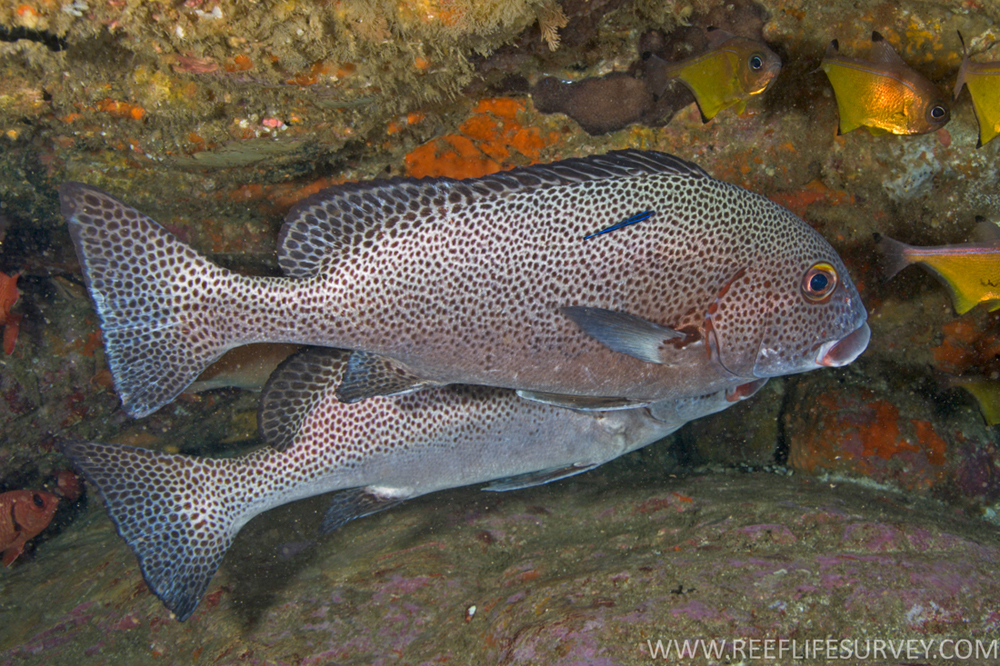Dotted Sweetlips, Plectorhinchus pica (Cuvier 1828)
Other Names: Magpie Sweetlips, Painted Sweetlips, Spotted Sweetlips

Dotted Sweetlips, Plectorhinchus picus, at Elbow Cave, Solitary Islands, New South Wales. Source: Andrew J. Green / Reef life Survey. License: CC by Attribution
Summary:
A pale greyish sweetlip covered in dark brown spots, with dark fins, often bright red pectoral and pelvic-fin bases, and reddish coloration on the inside of mouth, rear edge of maxilla, and gill membranes.
Cite this page as:
Bray, D.J. 2022, Plectorhinchus pica in Fishes of Australia, accessed 06 Jul 2025, https://fishesofaustralia.net.au/home/species/460
Dotted Sweetlips, Plectorhinchus pica (Cuvier 1828)
More Info
|
Distribution |
Ashmore Reef in the Timor Sea, and the northern Great Barrier Reef, Queensland, to Jervis Bay, New South Wales, with juveniles south to Montague Island; also reefs in the Coral Sea, and the Lord Howe Province in the Tasman Sea. Elsewhere the species occurs in the tropical, temperate, Indo-west-central Pacific: Socotra, Seychelles, Comoros, Madagascar and Mauritius (Mascarenes) east to Society Islands, north to southern Japan and Ogasawara Islands, south to Lord Howe Island, New Caledonia and Rapa. Inhabits lagoon and seaward reefs, where adults usually shelter in caves or beneath coral heads, often along reef margins. Juveniles are often seen in shallow lagoons. |
|
Features |
Dorsal fin XII-XIV, 17-20; Anal fin III, 7-8; Gill rakers 8-13 + 1 + 22-26 = 31-37. Lips fleshy, greatly swollen with age; chin with 6 pores but no median pit; |
|
Colour |
Juveniles are creamy white below, blackish above with a white snout and a pair of white saddles and spots along the body. Adults are covered with dark brown spots on head, back, sides, and fins, have a dark brown to blackish dorsal fin with a large black spots and a median horizontal grey stripe on the membranes only, the base and axil of the pectoral and pelvic fins are bright red in some individuals, the inside of mouth, rear edge of maxilla, and gill membranes are bright red to reddish-brown, and the abdomen is greyish mauve. |
|
Feeding |
Feeds on molluscs and crustaceans. |
|
Fisheries |
Fished commercially in parts of its range, and taken mainly with handlines and gillnets. |
|
Etymology |
The scientific name is from the Latin pica (= magpie), in reference to the black and white coloration of this species that resembles the colour of the Eurasian Magpie, Pica pica. Although this species has often been referred to as Plectorhinchus picus, Cuvier's name is based on the French word 'pie' (= magpie), a noun, therefore Cuvier's original spelling is retained. Cuvier referred to Diagramma pica as “Le Diagramme Pie.” |
|
Species Citation |
Diagramma pica Cuvier, in Guérin-Méneville (ed) 1828. Planches de Seba Vol. 3: pl. 26 (no. 32). Type locality: : Indian Ocean; Tahiti, Society Islands. |
|
Author |
Bray, D.J. 2022 |
|
Resources |
Dotted Sweetlips, Plectorhinchus pica (Cuvier 1828)
References
Allen, G.R. 1997. Marine Fishes of Tropical Australia and South-east Asia. Perth : Western Australian Museum 292 pp. 106 pls.
Allen, G.R. & Erdmann, M.V. 2012. Reef fishes of the East Indies. Perth : Tropical Reef Research 3 vols, 1260 pp.
Allen, G.R., Hoese, D.F., Paxton, J.R., Randall, J.E., Russell, B.C., Starck, W.A., Talbot, F.H. & Whitley, G.P. 1976. Annotated checklist of the fishes of Lord Howe Island. Records of the Australian Museum 30(15): 365-454 figs 1-2
Choat, J.H., van Herwerden, L., Robbins, W.D., Hobbs, J.P. & Ayling, A.M. 2006. A report on the ecological surveys undertaken at Middleton and Elizabeth Reefs, February 2006. Report by James Cook University to the Department of the Environment and Heritage. 65 pp.
Cuvier, G.L. in Guérin-Méneville, F.-E (ed.) 1828. Planches de Seba, Locupletissimi rerum naturalium thesauri accurata descriptio, accompagnées d'un texte explicatif mis au courant de la science et rédigé par unde réunion de Savans. Paris : F.-G. Levrault Vol. 3 fish plates 22-34.
Cuvier, G.L. in Cuvier, G.L. & Valenciennes, A. 1830. Histoire Naturelle des Poissons. Paris : Levrault Vol. 5 499 pp. pls 100-140.
Francis, M. 1993. Checklist of the coastal fishes of Lord Howe, Norfolk, and Kermadec Islands, southwest Pacific Ocean. Pacific Science 47(2): 136-170 figs 1-2
Francis, M.P. 2019. Checklist of the coastal fishes of Lord Howe, Norfolk and Kermadec Islands, southwest Pacific Ocean. figshare. Collection. https://doi.org/10.6084/m9.figshare.c.4428305.v2
Gill, A.C. & Reader, S.E. 1992. Fishes. pp. 90-93, 193-228 in Hutchings, P. (ed.) Reef Biology. A Survey of Elizabeth and Middleton Reefs, South Pacific. Canberra : Australian National Parks Vol. 3, Kowari 230 pp.
Johnson, J.W. 2010. Fishes of the Moreton Bay Marine Park and adjacent continental shelf waters, Queensland, Australia. pp. 299-353 in Davie, P.J.F. & Phillips, J.A. Proceedings of the Thirteenth International Marine Biological Workshop, The Marine Fauna and Flora of Moreton Bay. Memoirs of the Queensland Museum 54(3)
Kuiter, R.H. 1993. Coastal Fishes of South-eastern Australia. Bathurst : Crawford House Press 437 pp.
Kuiter, R.H. 1996. Guide to Sea Fishes of Australia. A comprehensive reference for divers and fishermen. Sydney, NSW, Australia : New Holland Publishers xvii, 434 pp.
Kuiter, R. & Kuiter, S. 2018. Coastal sea-fishes of south-eastern Australia. Seaford, Victoria : Aquatic Photographics, 371 pp.
McKay, R.J. 2001. Haemulidae. pp. 2961-2989 in Carpenter, K.E. & Niem, V.H. (eds). The Living Marine Resources of the Western Central Pacific. FAO Species Identification Guide for Fisheries Purposes. Rome : FAO Vol. 5 2791-3379 pp.
Playfair, R.L. 1868. The fishes of Seychelles. Proceedings of the General Meetings for Scientific Business of the Zoological Society of London 1867(3): 846-872
Randall, J.E., Allen, G.R. & Steene, R. 1990. Fishes of the Great Barrier Reef and Coral Sea. Bathurst : Crawford House Press 507 pp. figs.
Randall, J.E., Allen, G.R. & Steene, R. 1997. Fishes of the Great Barrier Reef and Coral Sea. Bathurst : Crawford House Press 557 pp. figs.










